10 mins
PUNCHING ABOVE IT'S WAIGHT
Mini and midi excavators are small in size but one of the fastest growing equipment segments. Not only that, they are being packed with increasing amounts of new technology as well as powered by alternative sources
USED MARKET SUCCESS
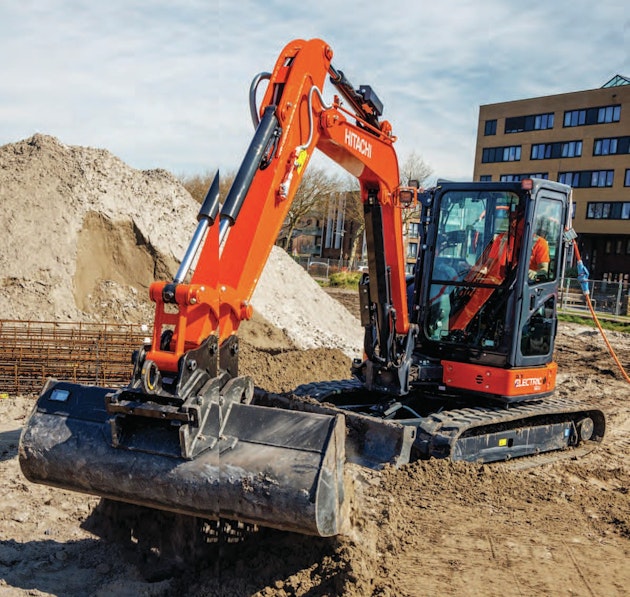
More and more features are now being integrated into smaller models that were previously only used in larger models
A new report from Ritchie Bros. on European Used Equipment Market Trends looking at transactional and listing data of four popular equipment categories sold: mini excavators, mobile excavators, crawler tractors, and agricultural tractors, reveals a large rise in the volume of mini excavators sold through the company’s auctions and Marketplace-E – a92% increase in Q4 2022 compared to the same period in 2021. “Around the world compact equipment is gaining in popularity among equipment users,” said Doug Olive, Senior Vice President of Pricing. “In the used equipment market, we can see this as well, with mini excavators leading the way. Across Ritchie Bros. channels, both supply and demand of this category have been exceptionally strong in Europe in the last three months of 2022, with median selling prices up 17% compared to the year before.”
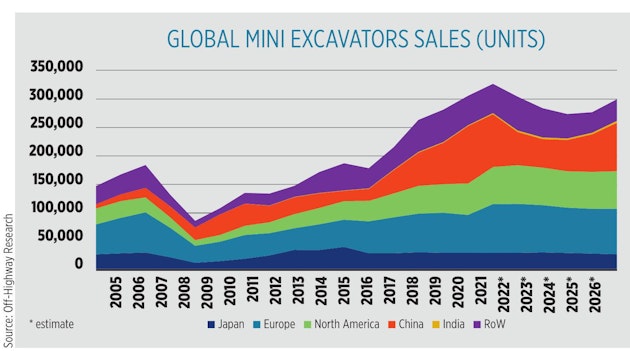
Charging electric equipment can be a challenge on some construction sites
Mini and midi excavators are small in size but one of the fastest growing equipment segments. Not only that, they are being packed with increasing amounts of new technology as well as powered by alternative sources, writes
Andy Brown
Many manufacturers in the construction industry, certainly the larger ones, have expansive product ranges. One of the reasons for this is financial – the more products a company can sell and service the more money can be made – but another one is simple necessity; construction is such a broad industry that it requires a wide selection of equipment. Out of all the equipment that is used in construction it is difficult to think of one that has grown in popularity quite as quickly as compact excavators such as the mini excavator (machines approximately 0-6 tonnes) and the midi (approximately 6-10 tonnes).
Excavator success story
“The first mini excavators were produced in Japan in the late 1960s and early 1970s as a tool of necessity in the country’s famously dense and crowded cities,” explains Chris Sleight, managing director, Off-Highway Research. “By the 1980s they were being exported to Europe and North America, but it was not until the early 1990s when Japanese asset prices collapsed and the economy stagnated that these overseas markets became much more important to the sector’s (still predominantly) Japanese suppliers.”
By the late 1990s, Europe had overtaken Japan as the world’s largest mini excavator market, while demand in North America was matching that of Japan by the mid-2000s. However, it was not until around 15 years ago that the popularity of mini excavators became truly established.
“The previous peak in sales was in 2007, just prior to the impacts of the Lehman Bros. collapse and global economic crisis. That year saw just under 185,000 mini excavators sold worldwide. Fast forward to 2021, the latest peak in the mini excavator cycle, and more than 325,000 units were sold,” says Sleight.
Two key factors have driven this growth: compact excavators have increasingly replaced traditional machine types like the backhoe loader in Europe and North America thanks to the attraction of a smaller footprint, full 360-degree slewing and lower prices than backhoe loaders; they have also started to sell in significant numbers in emerging countries. The most notable has been China, where the mini excavator market peaked at more than 100,000 machines sold in 2020.
Timur Abied, utility product manager at Volvo Construction Equipment (Volvo CE) tells International Construction that mini and midi excavators are among the OEMs fastest growing product segments with more efficient governance of energy being a main driver. This sentiment is backed up by Cédric Durand, product management director EMEA, Yanmar Compact Equipment, who says that mini and midi excavators have been growing strongly over the past years.
He adds that, “From one year to another the growth can differ from one country to the other but almost all countries had a strong growth.” Another smaller factor – but still important– behind the growth in the popularity of these machines is the increased use of attachments such as tiltrotators. “The growing popularity of tiltrotators has been a gamechanger for compact excavators, as tiltrotators allow an excavator operator to tilt and twirl an attachment 360 degrees,” says David Caldwell, national product manager, Takeuchi-US.
Technology as standard
New technology is increasingly being integrated into mini and midi excavators, often from what was originally reserved for larger models. Stephane Dieu, excavators product manager, Europe, Develon (previously Doosan), says that, “With the arrival of our DX-7 range, all of the new mini excavators in the range are now equipped with our DoosanConnect telematics system, which was restricted in the past to only our medium and heavy segments – 14 tonne and over in the excavators. This gives our customers the opportunity to fully monitor their compact fleet.”
Chris Bardas, product manager, Hitachi Construction Machinery, reveals that the OEM’s latest mini and compact excavator are, “equipped with ICT solutions, safety features such as rear- and side-view cameras, and benefit from the Zaxis-6 cab, which is renowned for being highly comfortable and spacious, with an ergonomic seat and user-friendly controls.”
Wacker Neuson’s Klaus Allerstorfer, product manager, excavators, agrees that, increasingly, features are being added to mini and midi excavators that in the past were only for bigger models.
“Overall, more and more features are now being integrated into smaller models that were previously only used in larger models,” he explains. “By features, I don’t just mean hardware, but also digital and data-driven solutions. One example is our EquipCare telematics solution, which makes it easier for our customers to manage their fleets and keep track of the condition of their machines.”
Alternative power options
Electric powered equipment is a major trend in construction, especially in compact machines such as mini and midi excavators which many believe are more suited to this type of power than larger machines.
As is the case with many OEMs, Hitachi Construction Machinery has recently launched new electric models in this segment (ZX55U6EB mini and ZX85-6EB compact) as has Takeuchi, with the all-electric TB20e. Caterpillar, the world’s largest OEM, announced last year that its construction industries division was working on four new electric equipment machines, including the 301.9 Electric Mini Excavator powered by a Cat 48V, 32kWh battery with a run time of up to eight hours on a single charge.
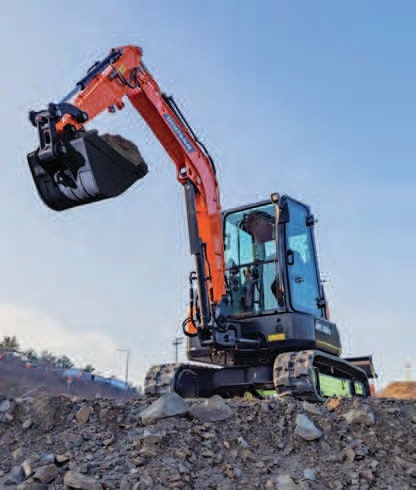
Compact excavators
have grown in popularity
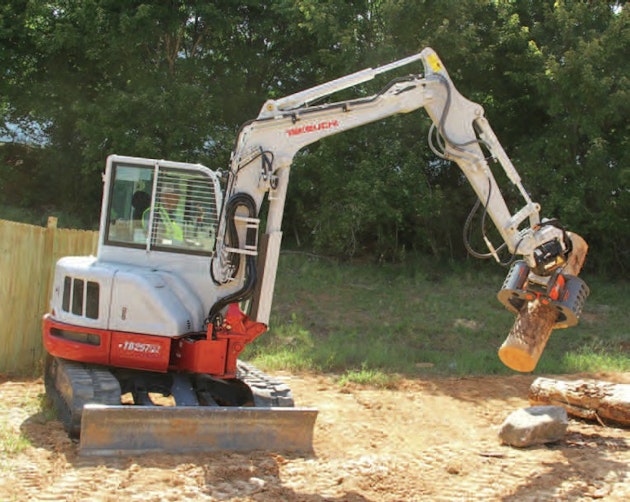
The increased adoption of tiltrotators has helped to add to the popularity of compact excavators
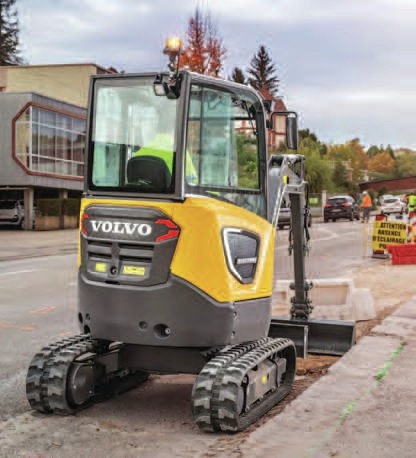
Volvo CE now has three compact electric excavator options commerically available
Zero emissions, low noise
Another new electric model is Bobcat’s 2-tonne mini-excavator the E19e – an electric version of the E19 internal-combustion model. It offers zero emissions, low-noise operation and comparable levels of performance to its dieselpowered counterpart. The Bobcat E19e features the same profile and external dimensions. It features a 3.5-hour battery capacity and can be recharged quickly using a super-fast charger, meaning that, by topping up the power during work breaks, the machine can be used all day for the majority of typical applications.
Scott Park, Doosan Bobcat CEO, commented, “With the introduction of the E19e, Bobcat has expanded its larger-size electric line-up of zero emission and quiet machines that can match the excellent performance of our conventional models.” Volvo CE has been at the centre of the development of electric powered construction equipment, with the OEM introducing its first electric compact models back in 2019 and now offering three compact electric excavators and two compact wheeled loaders. Volvo
They have been designed to provide similar levels of performance as diesel
CE’s Abied says that the company are not just looking at compact equipment though, adding that, “While we started with electric mini excavators, we have also grown into the development of mid-size solutions such as our EC230 Electric excavator.” While larger excavators may be increasingly electrified in the future, the focus is clearly on compact equipment such as mini and midi excavators.
USED MARKET SUCCESS
A new report from Ritchie Bros. on European Used Equipment Market Trends looking at transactional and listing data of four popular equipment categories sold: mini excavators, mobile excavators, crawler tractors, and agricultural tractors, reveals a large rise in the volume of mini excavators sold through the company’s auctions and Marketplace-E – a92% increase in Q4 2022 compared to the same period in 2021. “Around the world compact equipment is gaining in popularity among equipment users,” said Doug Olive, Senior Vice President of Pricing. “In the used equipment market, we can see this as well, with mini excavators leading the way. Across Ritchie Bros. channels, both supply and demand of this category have been exceptionally strong in Europe in the last three months of 2022, with median selling prices up 17% compared to the year before.”
A key point that OEMs make is that, as well as the benefits of electric power such as no emissions, no noise, no vibrations (thus a more comfortable environment for the operator), one thing is key: performance is just as good, if not better, than with diesel models. Bardas from Hitachi sums it up by saying, “One of the main advantages of our zeroemission mini and compact excavators, the ZX55U-6EB and ZX85U-6EB, is the high level of performance they provide. No compromises have been made in terms of performance and they have been designed to provide similar levels of performance as diesel alternatives. The fact that they are zero-emission and quieter than diesel models are additional benefits.”
Electric challenges
Despite all of the benefits that electric power brings, there are also challenges. Arguably the biggest one is the bottom line. To put it simply, electric machines are considerably more expensive than their diesel counterparts.
“When it comes to battery-powered solutions, the purchase price can be a hurdle,” admits Allerstorfer from Wacker Neuson. “But if you look at the total cost of ownership, the e-machines score with very low maintenance and operating costs, which in turn convinces many customers. In addition, we have found that renting the machines can help to quickly overcome initial doubts.” Durand from
Yanmar agrees that the higher cost is putting off some, but also makes the point that the total cost of ownership over the life of the machine can be less. “Indeed, the purchase cost is still higher than with traditional ICE machines. In the long run this price premium should decrease, and we are looking into the total cost of ownership as well which, at the end, is certainly the best criteria for profitability,” he says.
Another issue is undoubtably with charging and infrastructure. If construction is taking place on a remote site and not in a city then there may not be a power source to charge the battery. At the moment there are no universal standards regarding charging hardware and protocols.
“The lack of charging infrastructure and the still slower pace of introduction is a challenge and we need all stakeholders to help deliver the ecosystem required to support our electric machines and, in doing so, together achieve the strategic objectives of the Paris Agreement,” says Volvo CE’s Abied.
“High energy costs and the lack of financial and legal incentives also hamper deployment of strategic initiatives supporting electric power as the competitive solution for mini and midi excavators.”
Out of the box solutions
When it comes to charging solutions increasing numbers of companies are producing fast charging options and
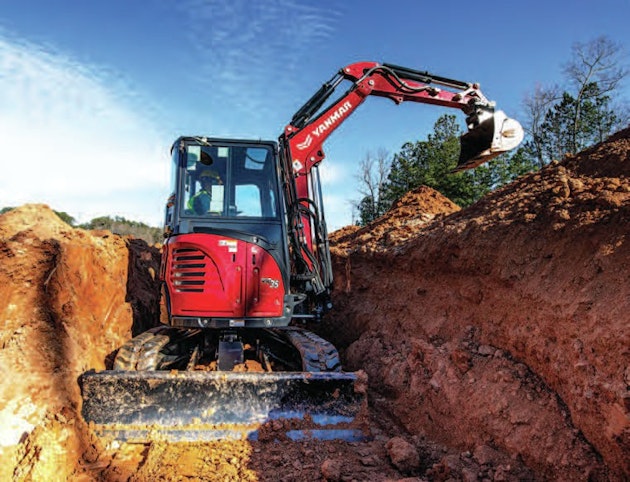
Sales of mini and midi excavators have increased
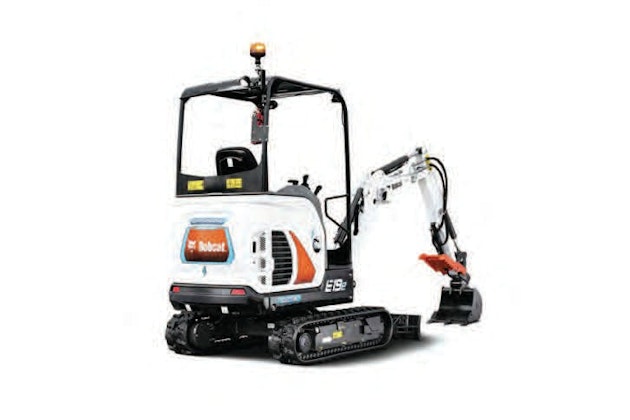
Bobcat’s 2-tonne E19e – an electric version of the E19 internal-combustion model
The lack of charging infrastructure and the still slower pace of introduction is a challenge

Wacker Neuson’s EW100 at work on a jobsite

Caterpillar announced four battery electric machine prototypes last year, including the 301.9 mini excavator
there are other options, such as Wacker Neuson’s ‘charging box’. “We are not only focusing on the development of zero emission products, but are also looking at entire construction site solutions,” says Allerstorfer.
“We will soon be launching our Charging Box, a mobile power bank for the construction site. This will enable customers to charge their zero emission products easily – and above all independently from local power sources.”
Future developments
While electric mini and midi excavators are growing in popularity, the number of models sold are very small compared to diesel models. So, what’s next for these diesel models? More new technology being integrated into them that makes the life of an operator easier, and was previously reserved for larger machines, is one trend that will continue.
“These newer technological features all have one thing in common – they’re designed to help operators stay comfortable and more productive,” says Caldwell from Takeuchi US. “They also help ensure that operators know exactly how their machines are performing by providing a great deal of information at their fingertips.”
In Wacker Neuson’s newest excavator, the wheeled EW100, Allerstorfer says that, “Digitisation played a major role in the development of this machine. For example, we have implemented an intelligent attachment management, a state-of-the-art Human-Machine-Interface, and the preparation for various assistance systems for process optimisation.”
Regarding sales around the world, mini and midi excavators are expected to continue to see strong numbers, if perhaps not at the same levels as in recent years.
Mini excavators are machines which replace manual labour. With the economic driver of rising labour costs (plus the difficulty in finding workers ) added to the fact that the purchase cost for these machines is cheaper than ever, adoption will continue.
“Drivers like these are at play in emerging markets, and the large-scale mini excavator industry which has sprung up in China means that machines are more affordable now than they were before,” says Off Highway Research's Sleight. “This will help drive the adoption of this type of compact equipment around the world in the years to come.”
It will be interesting to see just what technology and power sources these mini and midi excavators of the future are equipped with as standard.